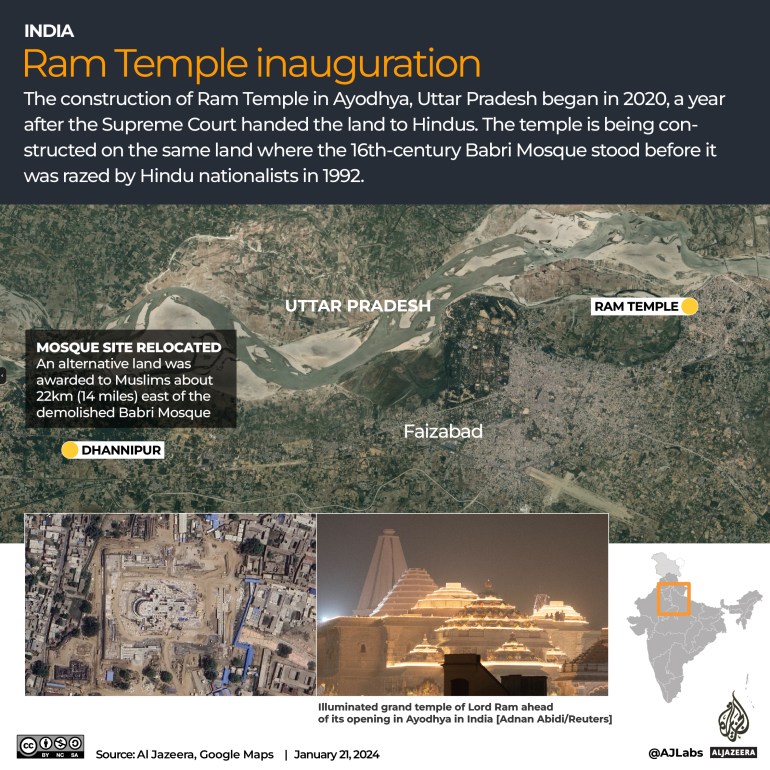
India’s Prime Minister Narendra Modi has opened a Hindu temple built on the ruins of a historic Mughal-era mosque in the northern town of Ayodhya.
Monday’s consecration of the temple, dedicated to Lord Ram, embodies the triumph of Modi’s muscular Hindu nationalist politics and marks an unofficial start to his re-election campaign in general elections scheduled later this year.
Modi, in flowing golden-coloured traditional dress, unveiled the black stone idol to the deity in the heart of the 50-metre-high (164 feet) temple in Ayodhya, nearly 700km (435 miles) east of New Delhi.
The temple has been built on grounds where the Babri mosque, named after Mughal emperor Babur, stood for centuries before it was torn down in 1992 by a Hindu mob.

The demolition of the 16th-century mosque triggered the worst religious riots since independence – killing more than 2,000 people, most of them Muslims – and shook the foundations of India’s officially secular political order.
Modi on Monday chanted Hindu religious verses before placing flower petals at the feet of the deity and clasped his palms in prayer, then bowed before it and circled a sacred flame, while outside, a military helicopter showered petals on the temple.
Traditional clarinets played devotional music during the rituals for the 130cm (51-inch) tall, black stone deity that represents the god-king while politicians, businessmen, sports and film celebrities watched along with millions nationwide.
“January 22, 2024 is not merely a date in the calendar but heralds the advent of a new era,” Modi said, speaking outside the temple after the consecration.

Most of India’s opposition parties, including the Indian National Congress, declined the invite to the event, saying it did not befit a secular India.
But for Modi, the temple’s opening is a landmark moment in a decades-long campaign to align the country’s governance with its majority faith.
Hindus make up about 80 percent of India, the world’s most populous country, which is also home to some 200 million Muslims who have frequently come under attack by Hindu nationalists since Modi’s rise to power in 2014.
The legend of Ram
The temple is the sacred abode of Ram, one of the Hindu pantheon’s most popular gods.
Millions of Hindus worship Ram with a belief that chanting his name in times of adversity will bring peace and prosperity, and most of those who practice Hinduism keep idols of Ram in their homes.
Major Hindu festivals such as Dussehra and Diwali are associated with mythological tales of Ram extolling the virtues of truth, sacrifice and ethical governance.
The mythological Hindu epic Ramayan, which tells the story of Ram’s journey from prince to king, has often been adapted in popular culture. One of the most-viewed fabled shows is the TV series Ramayan, created in the 1980s, which continues to have a faithful audience.
Ram’s divinity is not only the dominant religious force in India but also part of the ancient cultural heritage in countries like Thailand, Indonesia, Myanmar and Malaysia.

The Ayodhya dispute
Devout Hindus believe Ram was born in Ayodhya more than 7,000 years ago, but that the Babri mosque was built over his birthplace by one of Babur’s generals. That put the town at the centre of India’s turbulent politics and the Hindu majoritarian quest to redeem the country’s religious past for decades.
In December 1949, authorities seized the mosque after members of a right-wing Hindu group placed idols of Ram inside the disputed structure. Court orders barred the removal of the idols, and the structure’s use as a mosque effectively ceased.
Hindu and Muslim groups filed separate claims over the site and the structure. In 1989, another court ordered the maintenance of the status quo.
Hindu and Muslim groups tried unsuccessfully to resolve the dispute through talks, before the BJP launched a nationwide campaign in 1990 to build the temple.
Lal Krishna Advani, the president of the party at the time, embarked on a cross-country journey on a truck fitted out to resemble an ancient chariot. It whipped up Hindu fervour, deepening rifts with Muslims but also catapulting the party to national prominence.
The BJP campaign climaxed in a rally in Ayodhya on December 6, 1992, when a mob climbed the mosque and smashed its domes with axes and hammers, levelling the entire structure. The event triggered sectarian riots in several parts of India, killing about 2,000 people, mostly Muslims.
As a foot soldier of the party at the time, Modi helped organise the chariot’s journey, which began in his home state of Gujarat. He rode to the office of prime minister in 2014 on a Hindu nationalist platform that included the promise to build the Ram temple.
Hindus won a prolonged legal battle in 2019, allowing them to build the temple, while the Muslims were given a plot miles away from the site of the razed Babri mosque to build a new structure.
In 2020, Modi, the face of an unprecedented and unapologetic fusion of religion and politics in India, led the Ram temple’s groundbreaking ceremony. But critics say the idea of a diverse, constitutionally secular state leading a Hindu religious ritual is deplorable.







